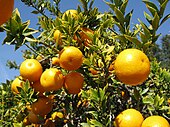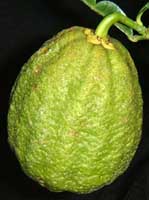Frost hardy citrus plants

Frost hardy citrus plants are called citrus plants with increased winter hardiness , which can be grown far beyond the traditional citrus growing areas. Citrus species and citrus hybrids , which are usually described as frost hardy , show the ability to withstand temperatures below -5 to -15 ° C.
Frost-hard citrus plants are divided into real, also pure ( uncrossed ) types ( e.g. Satsuma , Mandarine , Kumquat ) or hybrids ( crossed ) (e.g. Citrange, Citrandarin, Yuzu ) which have been crossed with different types of citrus plants. All citrus fruits are edible, but some of them have bitter aromas or the juice has an astringent effect , which is often perceived as unpleasant, which is often the case with the frost-hardy varieties.
Citrus hybrids with the three-leaved orange as a parent often contain the bitter and unpleasant-tasting poncirin , an oil found in these fruits. Those considered “freshly inedible” or “conditionally edible” can (like all citrus fruits) be cooked to make jam. All genera are so closely related and intercrossable that they are generally referred to below as citrus plants.
cultivation
The cultivation of the individual species is always specific; the prevailing microclimate (e.g. frost , solar radiation, wind, soil conditions, age of the plant, etc.) in the garden should be compared with the requirements of the respective citrus plant. The citrus plants can be helped over the winter with some fleece and with sensitive plants (e.g. variety, young plants) or in cold regions with a heating coil.
Real citrus species
Below is a table with some “real frost hardy” citrus plants. The frost hardiness can vary slightly from specimen to specimen, also depending on the age of the plant. Sorted according to frost hardness (rising temperature).
| Surname | Frost hardiness | edibility | annotation | photos |
|---|---|---|---|---|
| Trifoliate orange ( Poncirus trifoliata ) | down to –30 ° C | Not edible fresh | It is very often used as a base for citrus refinements and is very easy to cross with other citrus plants, although it is not a "real" citrus plant . The only hardy citrus species in Central Europe . Deciduous. |

Fruits of three-leaved oranges with leaves
|
| Ichang papeda ( Citrus ichangensis ) | approx. -15 ° C | Very bitter, not eaten fresh | Is very popular as a base or for crossing due to its very high tolerance to frost. Frost hardest "real" citrus plant. Evergreen . |

Ichang papeda fruits with leaves
|
| Jiouyuezao mandarin ( Citrus reticulata 'Jiouyuezao') | approx. –13 ° C | Edible | Has been cultivated in China for a very long time . Evergreen. | |
| Kumquat ( Citrus japonica ) | approx. -12 ° C | Edible | Fruit is eaten with the peel. Evergreen. |

Kumquat fruits and leaves
|
| Changsha mandarin ( Citrus reticulata 'Changsha') | approx. –11 ° C | Edible, but contains many seeds | Has been cultivated in China for a very long time . Evergreen. | |
| Chinotto ( Citrus myrtifolia ) | approx. –8 ° C | Edible | Has long been cultivated in southern Italy , Malta and Libya . Evergreen. | |
| Australian desert lime ( Eremocitrus glauca ) | -5 ° C to -10 ° | Edible | Is often used for crossing or is used as a base. Evergreen. |
Citrus hybrids
Here is the table with some hybrids, some of which are very frost-hardy . The frost hardiness can vary slightly from specimen to specimen, also depending on the age of the specimen. Sorted according to frost hardness (rising temperature).
| Surname | Frost hardiness | edibility | annotation | photos |
|---|---|---|---|---|
| Citrandarin ( Citrus reticulata × Poncirus trifoliata ) / ( Mandarine × Trifoliate Orange ) | about −18 ° C | Conditionally edible | The "Changsha" citrandarin is the most frost-hardy hybrid. Partly deciduous. | |
| Citrumelo ( Citrus × paradisi × Poncirus trifoliata ) / ( Grapefruit × Trifoliate Orange ) | about −15 ° C | Conditionally edible | The "Dunstan" is probably the best tasting citrumelo . Partly deciduous. | |
| Citrange ( Citrus × sinensis × Poncirus trifoliata ) / ( Orange × Trifoliate Orange ) | about −15 ° C | Conditionally edible | The "Rusk" is probably the best tasting citrange . Partly deciduous. | |
| Citrangequat ( Citrus japonica × ( Citrus × sinensis × Poncirus trifoliata )) / ( Kumquat × Citrange ) | about −15 ° C | Edible | The "Thomasville" is probably the best tasting citrus quat . Evergreen. | |
| Yuzu ( Citrus ichangensis × Citrus reticulata ) / ( Ichang papeda × Tangerine ) | about −12 ° C | Used for cooking | Cultivated in Japan for a very long time . Evergreen. | |
| Hybrid USA 119 Segentrange (( Citrus paradisi × Poncirus trifoliata ) × Citrus sinensis ) / (( Grapefruit × Trifoliate Orange ) × Orange ) | about −12 ° C | Edible | Good, frost-hardy orange substitute. Crossed in Florida in 1973 . Partly deciduous. | |
| Sanford Curafora Segentrange (( Citrus sinensis × Poncirus trifoliata ) × Citrus reticulata ) / (( Orange × Trifoliate Orange ) × Tangerine ) | about −12 ° C | Edible | Good, frost-hardy tangerine substitute. 1957 in Florida selected . Partly deciduous. | |
| Ichang lemon ( Citrus ichangensis × Citrus maxima ) / ( Ichang papeda × grapefruit ) | about −10 ° C | Edible | Can be used as a frost-hard lemon substitute. Evergreen. | |
| Satsuma ( Citrus × aurantium , Syn .: Citrus unshiu - Hybrid Citrus reticulata × Citrus maxima ) / ( Mandarine × Grapefruit ) | about −10 ° C | Edible, tasty | Has been cultivated in China for a very long time . Evergreen. |

Satsuma Grove
|
| Orangequat ( Citrus sinensis × Citrus japonica ) / ( Orange × Kumquat ) | about −9 ° C | Edible | The “Nippon” is probably the most promising in terms of taste and frost hardiness. Evergreen. | |
| Citrangedin (( Citrus × sinensis × Poncirus trifoliata ) × Citrofortunella microcarpa ) / ( Citrange × Calamondin orange ) | about −8 ° C | Edible | The fruit is small, orange and has a sour taste. The leaves can look very different on the same plant. Partly deciduous. |
swell
- ab Isolation of genes from cold acclimated Poncirus trifoliata and Citrus unshiu (abstract)
- China / FAO Citrus Symposium: Mandarin-like Hybrids of Recent Interest for Fresh Consumption. Problems and Ways of Control.
- Sauls, JW, & Jackson, LK Cold-Hardy: Citrus for North Florida. Document FC-36. University of Florida, IFAS Extension.
- from Cold Hardy: Citrus and Hybrids. Lime (Citrus Friends Europe Newsletter) 8: 1–2
- Bernhard Voß: Citrus plants from tropical to hardy , Humbach & Nemazal, 1997, ISBN 3-9805521-3-6
- Bernhard Voß: Citrus Plants , Franckh-Kosmos Verlags-GmbH, 2005, ISBN 3-440-10174-6



